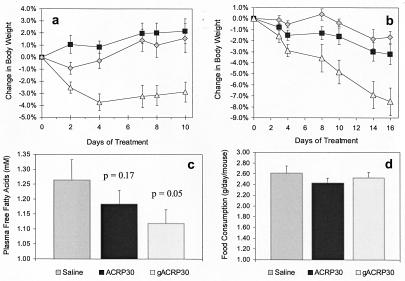Figure 5.
Effects of long-term treatment with gAcrp30 on mice fed a high-fat diet. (a) Ten-week-old male C57BL/6J mice were put on a high-fat/sucrose diet for 19 days. The average body weights at this time were 29.0 ± 2.4, 29.3 ± 2.2, and 32.0 ± 2.6 g for control, Acrp30, and gAcrp30 groups, respectively. The mice were then treated by continuous infusion with either 2.5 μg gAcrp30/day (▵), 5 μg Acrp30/day (■), or physiological saline (◊). The mice were continued on the high-fat diet, and their body weight was recorded. Mice treated with gAcrp30 experienced a significant weight reduction (−3.7%, P = 0.002) during the first 4 days. This reduction in body weight remained significant throughout the study. (b) C57BL/6J mice were fed a high-fat diet for more than 6 months before treatment. The average body weights at this time were 51.2 ± 4.5, 51.9 ± 4.1, and 54.3 ± 3.2 g for control, Acrp30, and gAcrp30 groups, respectively. Three groups of mice (n = 8, each) were injected twice daily with gAcrp30 (▵, 25 μg per injection), Acrp30 (■, 25 μg per injection), or saline (◊). Body weights were recorded at the indicated time points. Treatment with gAcrp30 led to significant (P < 0.05) weight loss at day 3. This effect became even more significant as the study continued. The animals had lost 7.5% of their initial body weight at day 16 (P = 0.001). (c) This effect was paralleled by a drop in plasma FFAs, which reached statistical significance (P < 0.05 vs. saline) at day 3 and persisted throughout the study. Shown is the plasma FFA level at day 16 of the study. The initial FFA plasma concentration was the same in all three groups. (d) Daily food intake averaged over the course of the study was not significantly different in either treatment group when compared with saline-injected animals.

